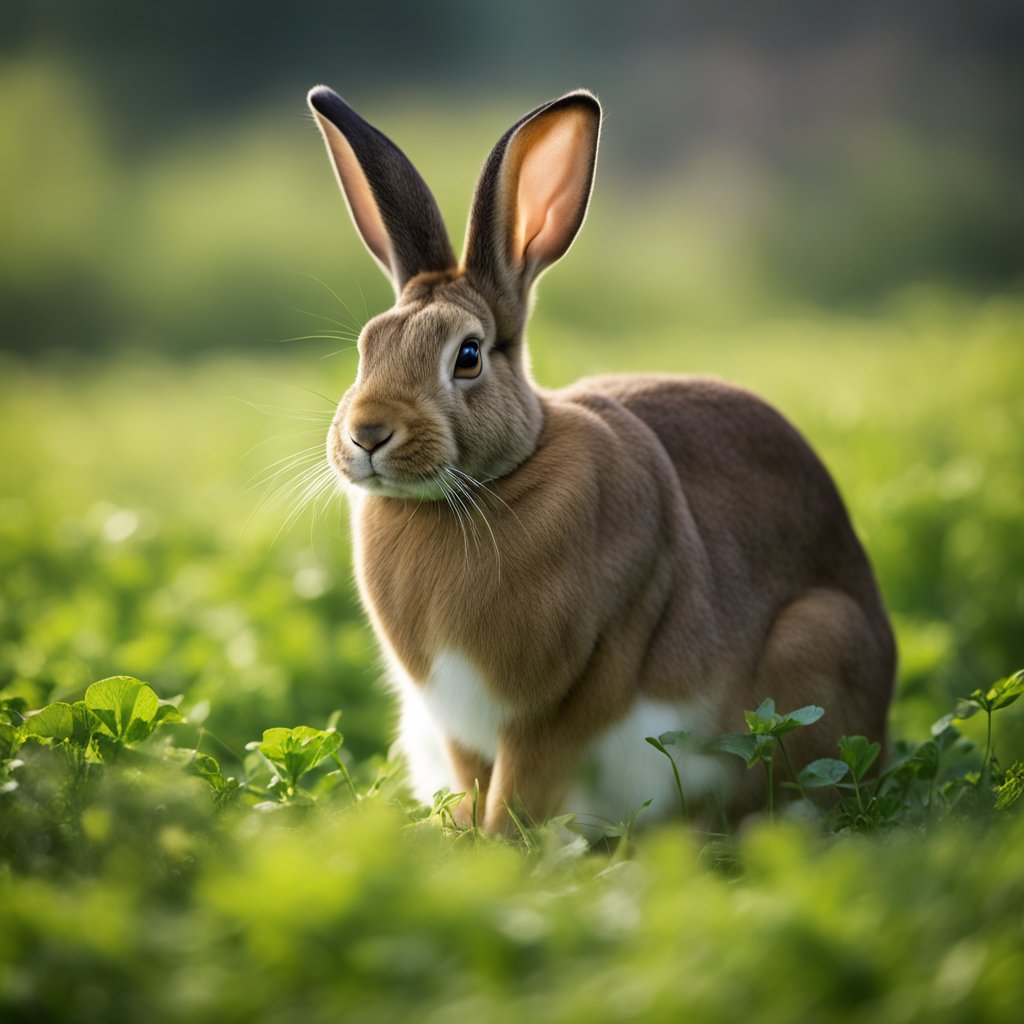Flemish Giant Rabbit: A Comprehensive Guide to Care and Characteristics
Flemish Giant Rabbits are noteworthy for their impressive size and gentle nature. This breed is recognized as one of the largest in the world, making them fascinating and lovable pets for families and individuals alike. Their origins trace back to Belgium, where they were initially bred for meat and fur, but today, they are cherished companions.

Caring for a Flemish Giant requires understanding their unique needs. They thrive in spacious environments and require a specific diet to maintain their health. With the right knowledge, owners can enjoy a rewarding relationship with these gentle giants, who often possess calm and friendly temperaments.
Flemish Giants are more than just large rabbits; they play a significant role in their owner’s lives. Their impressive size and loving nature have made them popular both as pets and in competitive shows. Those considering adding a Flemish Giant to their family will find a devoted and gentle companion.
Key Takeaways
- Flemish Giant Rabbits are the largest breed of domestic rabbits.
- They require specific care and space for a healthy life.
- Their affectionate nature makes them ideal companions for many households.
Breed Overview

The Flemish Giant Rabbit is known for its impressive size and unique history. This breed has a rich past and distinct physical traits that make it a fascinating choice for rabbit enthusiasts.
History and Origin
The Flemish Giant originated in Flanders, Belgium, where it was bred as early as the 16th century. It is believed to have descended from various meat and fur breeds, including the extinct European “Patagonian” breed. The breed was developed near the city of Ghent, primarily for agricultural purposes.
By the late 19th century, Flemish Giants began to gain popularity as pets and show animals. Their large size and gentle temperament made them appealing to families and breeders alike. The National Federation of Flemish Giant Rabbit Breeders was established in 1915 to promote and standardize the breed.
Physical Characteristics
Flemish Giants are among the largest rabbit breeds. Adult rabbits typically weigh between 14 to 20 pounds, with some individuals exceeding 25 pounds. They have a long, strong body and a broad, rounded head.
These rabbits have large, upright ears that can reach up to 8 inches in length. Their strong legs support their hefty frame. The coat is dense and soft, adding to their attractiveness. Proper care and nutrition are essential to maintain their health and appearance.
Color Varieties
Flemish Giants come in several color varieties. Some of the most common include:
- Steel Grey: A rich, dark grey shade.
- Fawn: A warm, light brown coat.
- Light Grey: A softer, lighter hue.
- Black: A rich, deep black.
- Blue: A unique slate-blue color.
These color variations add visual appeal to the breed. Depending on the breed standards, certain colors may be more desirable in the show ring. Each variety retains the same key physical characteristics, which makes them instantly recognizable as Flemish Giants.
Care and Management

Caring for a Flemish Giant Rabbit involves understanding its unique needs in diet, housing, health, and socialization. Proper management ensures they thrive and remain healthy companions.
Dietary Requirements
Flemish Giant Rabbits require a balanced diet to support their large size and active lifestyle. Their main food includes high-quality hay, which provides essential fiber. Fresh vegetables are also crucial; they should have around 2 cups of chopped leafy greens for every 6 pounds of body weight.
Limited amounts of fruits and carrots can be given, no more than 2 tablespoons per 3 kg daily. Fresh water should always be available to keep them hydrated. Avoid feeding them processed foods and ensure all vegetables are safe for rabbits.
Housing Needs
A suitable living environment is essential for a Flemish Giant Rabbit. They need a spacious enclosure that allows them to stretch and move comfortably. A cage should be at least 36 inches long, 30 inches wide, and 30 inches tall for adequate space.
Using bedding made from hay or paper products helps maintain cleanliness. The area should be free from drafts and direct sunlight. It’s vital for the rabbit to have a safe area to play outside the cage, as this encourages more natural behaviors.
Health and Veterinary Care
Regular health checks and veterinary care are necessary to keep Flemish Giant Rabbits healthy. Annual checkups can help spot any potential issues early. Common health concerns include dental problems, obesity, and gastrointestinal issues.
Maintaining a clean living space also prevents disease. Vaccinations and spaying/neutering should be part of the care plan. Owners should monitor their rabbits for any unusual behaviors or signs of illness, such as changes in eating or grooming habits.
Exercise and Social Interaction
Exercise and social interaction are crucial for a Flemish Giant Rabbit’s well-being. They should have at least 2-4 hours of exercise outside their cage daily. Providing toys and obstacles helps keep them active and mentally stimulated.
This breed is known for being friendly and social, so they thrive on interaction with humans and other rabbits. Regular bonding time not only strengthens the relationship but also reduces stress and loneliness. It’s important to create a safe space for play to prevent accidents.
Breeding

Breeding Flemish Giant rabbits involves specific considerations and understanding their gestation periods and litter details. Careful planning can lead to successful outcomes and healthy offspring.
Breeding Considerations
When breeding Flemish Giants, several factors should be kept in mind. Selecting healthy breeding pairs is crucial. Both rabbits should be well-nourished, free from diseases, and have good temperaments. It is essential to ensure that the rabbits meet breed standards for quality.
Breeders often consider genetics and the history of each rabbit. Genetic diversity can prevent health issues in the offspring. It is also essential to monitor the timing of breeding. A female rabbit, or doe, is ready when she shows signs of heat, which occurs every 14 to 21 days.
Lastly, attention should be given to proper housing during breeding. Rabbits need a comfortable and secure environment to reduce stress and enhance breeding success.
Gestation and Litter Information
The gestation period for Flemish Giant rabbits typically lasts about 30 to 34 days. Understanding this timeline helps breeders prepare for the arrival of the kits.
Doe will create a nesting area from fur she pulls from her belly, which provides warmth and safety for newborns. Litters can range from 6 to 10 kits, although some can have as many as 15 to 19. Each kit is born hairless and blind.
Breeders should monitor the doe during her pregnancy and after the birth for any health issues. Providing quality food and plenty of water is crucial during this time. After a few weeks, kits begin to grow fur and open their eyes, allowing breeders to start thinking about their future homes.
Uses and Societal Impact

Flemish Giant rabbits serve various roles in society, particularly as pets and in competitive environments. Their size and gentle nature make them appealing companions, while their participation in shows highlights their distinctive qualities.
As Pets
Flemish Giant rabbits are popular pets known for their friendly disposition. They enjoy interacting with their owners and often form strong bonds. Due to their size, they require ample space to move around, making a spacious living environment essential.
These rabbits thrive on social interaction, needing companionship to avoid loneliness. Providing toys, tunnels, and safe areas for exploration can greatly enhance their well-being. With proper care and attention, Flemish Giants can live between 8 to 12 years, offering long-term companionship.
In Shows and Competitions
Flemish Giants are frequently featured in rabbit shows and competitions. Their impressive size, defined by standards set by various rabbit breeds’ associations, showcases their unique physical traits. Judges typically evaluate them based on size, color, fur quality, and overall health.
In competitive settings, breeders strive to produce rabbits that meet these specific criteria. Success in these competitions can enhance a breeder’s reputation and contribute to the promotion of the breed. Many owners find joy in showing their rabbits, combining their passion for the breed with community involvement.
Resources

For those interested in Flemish Giant Rabbits, various resources are available to enhance understanding and care.
Books:
- The Rabbit Resource by Bob McGowan
- Rabbits for Dummies by Audrey Pavia
Online Guides:
- A thorough guide to Flemish Giant breeding can be found on Flemish Giant Rabbit Breeding.
- For general breed information, visit Animal Corner – Flemish Giant Rabbit.
Community Forums:
- Joining communities like the ARBA can provide valuable insights and support from experienced breeders and owners.
Care Tips:
- For detailed care instructions, check the comprehensive guide at Rabbit Care Tips.
YouTube Channels:
- Educational videos on rabbit care can be found on channels dedicated to pet rabbits, which cover topics like diet and habitat setup.
These resources guide anyone looking to learn about or care for Flemish Giant Rabbits effectively. They can help ensure a good quality of life for these gentle animals.
Frequently Asked Questions

Flemish Giant rabbits have unique needs and traits that potential owners should understand. This section addresses common queries about their lifespan, size, weight, characteristics, meat production, and habitat needs.
How long do Flemish Giant rabbits typically live?
Flemish Giant rabbits generally have a lifespan of 8 to 12 years when properly cared for. Factors such as diet, habitat, and healthcare play important roles in their longevity.
What is the average size of a Flemish Giant rabbit?
The average size of a Flemish Giant rabbit ranges from 2.5 to 4 feet long. Their large body frame sets them apart from smaller rabbit breeds.
How much does a Flemish Giant rabbit weigh?
Flemish Giant rabbits commonly weigh between 10 to 22 pounds. Some individuals can exceed this range, with weights over 20 pounds being recorded.
What are the main characteristics of Flemish Giant rabbits?
Flemish Giant rabbits are known for their gentle temperament and friendly nature. They are often described as social and adaptable, making them suitable pets for families.
Can Flemish Giant rabbits be kept for meat production?
Yes, Flemish Giant rabbits can be kept for meat production. They were originally bred for this purpose due to their size and rapid growth rate.
What type of habitat is best for a Flemish Giant rabbit?
A spacious cage or outdoor hutch is ideal for a Flemish Giant rabbit. The enclosure should provide ample room for movement and exploration, ensuring they remain comfortable and healthy.

